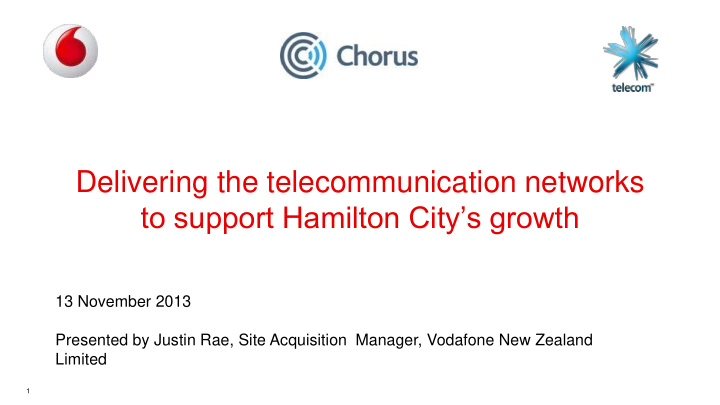



Delivering the telecommunication networks to support Hamilton City’s growth 13 November 2013 Presented by Justin Rae, Site Acquisition Manager, Vodafone New Zealand Limited 1
Introduction • The purpose of this presentation is to outline the common types of telecommunications network infrastructure, which are required to support the growth predicted in the Hamilton Urban Growth Plan over the next 30 years. (140,000 people live here now, by 2041-225,000 are expected, a 60% increase.) • We will run through recent New Zealand industry developments, the nature of growth in demand for services, and how this drives expansion of existing networks and new technologies. • Overall the information presented can then be used to inform the more detailed submissions on the Proposed District Plan to be presented as evidence. 2
Major Telecommunications Industry Developments • The successful entry to the market of a third cellular mobile operator, Two Degrees Mobile Limited. • The establishment of Chorus Limited following its demerger from Telecom Corporation of New Zealand Limited. • The public private partnerships formed to rollout broadband infrastructure to the majority of New Zealanders. These include the Ultra Fast Broadband (UFB) and Rural Broadband Initiative (RBI). • The Vodafone-TelstraClear merger brings together significant fixed line and mobile infrastructure 3
Key Themes for Discussion • Telecommunications (fixed and mobile) are a basic and essential utility requirement like transportation, electricity and water supply . • People want to be connected anywhere, anytime – technology is irrelevant to them whether it be fixed, mobile or wifi – they just want it to work. • Mobile data growth has been doubling year on year - Predicted to grow to1GB/user/day by 2020. • Telecommunication services are crucial for sustainable business and community growth in Hamilton. • Network operators must continue to develop their networks to enable Hamilton’s growth. 4
Sensors Everywhere… in Everything Everything that can be connected … will be connected… and most will be connected 5 5 wirelessly
Future Technology Requirements • A combination of various capacity expansion and technology solutions will be required to meet Hamilton's projected growth • More spectrum and more efficient use of radio spectrum Technology advancements will increase the efficiency of current spectrum. • Upgrades of existing infrastructure Additional, bigger equipment added to existing sites, similar to co-location to provide for LTE and advanced multi band antenna technology. Important to make efficient use of existing infrastructure, reduces requirements for new sites. • More new sites New cell sites (macro and micro) especially in high mobile traffic areas will be required to meet demand. Property developments can require existing sites to be moved. 6
Cell site types Monopole with head Monopole Rooftop site Lamp post site frame 7
Small Cell Sites and Fixed Network Cabinets Lamp post Micro/Pico Fixed network street Cell cabinet Bus stop Micro/Pico Cell 8
Key Points in Relation to the Proposed District Plan • Make the most of zones like industrial areas especially, allow larger (wider) sites to reduce the numbers that otherwise might be required, and foster co-location. • Have rules that encourage changes in technology and allow equipment to be readily added to existing sites. Better to use existing over new. • Preserve as much as possible the national consistency of the Telecommunications NES, by limiting local exclusions to truly special areas. 9
Recommend
More recommend